
ごあいさつ
バイダルカ復元は新月にはじめると決めていた。太古のアリュートはきっと月の満ち欠けに即した暮らしをしていたに違いないと信じるからだ。
本来バイダルカを作ると言うことは、生き延びる術を生み出す作業である。自らの目で見た、他の命の形から、何かを感じ、考え、そして願いや希望を具現化する作業だ。
大空を飛ぶ鳥を見た人は、鳥のように自由に羽ばたきたいと願い飛行する術を生み出した。大海原を行き交う、ラッコやアザラシ、クジラを見て、彼らのように海を行き交おうと願い、その術を生み出した。
バイダルカを復元するということは、その形のなかに、古代の人びとの心模様と記憶を織り込むことだと考える。形にばかり目を奪われていては、伝えなければならないことが伝わらない。
アリュートの叡智に敬意を払いつつ、さあ、バイダルカの復元をはじめよう。
Greeting from the author
I decided to begin a project of this Baidarka reconstruction in the new moon, because I believe, that Aleut of the ancient time lived as according with waxing and waning of the moon.
Building baidarka is, I believe, work to create surviving art. And also it is work to embody a wish and a hope, while making form of other creature a hint.
The person who watched a flying bird in the sky wanted to flap and fry like them, he/she might brought about art to fry.
Aleutian people watched sea-otter and seal, whales who passed away in the sea, and they created the art to go on the sea.
I think that reconstruction of baidarka is incorporating hearts and memories of ancient Aleut. We can not arrive at really important things if we were fascinated?by only the form and the appearance of them.
While paying huge respect to wisdom and history of Aleut, let’s begin the reconstruction of baidarka.

2006年11月21日 材を選ぶ
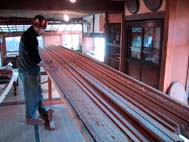 バイダルカの骨格は木を組み上げ形を作る。トウヒやヒバ、ヒノキなど針葉樹から、木目が通り節の無い素性のよろしい材を使う。材をあちらから眺め、こちらから眺め、ゆさぶり、じっくり時間をかけて反りの合う物同士を選び出す。 バイダルカの骨格は木を組み上げ形を作る。トウヒやヒバ、ヒノキなど針葉樹から、木目が通り節の無い素性のよろしい材を使う。材をあちらから眺め、こちらから眺め、ゆさぶり、じっくり時間をかけて反りの合う物同士を選び出す。
今日は、バイダルカの骨格の最も大切な部分となる、ガンネル、ストリンガー、いずれも船首から船尾に伸びる材を選びだす。
写真の材はアラスカ南部で伐採されたトウヒだ。このトウヒは直径1m、長さは切断されているが6m、樹齢は400年を越えていた。
 これだけの材を集めるのに3年かかり、数本のトウヒの巨木を分いた。5m以上の長さで木目が通り節の無い材を取るのは、それはそれは難しい事なのだ。 これだけの材を集めるのに3年かかり、数本のトウヒの巨木を分いた。5m以上の長さで木目が通り節の無い材を取るのは、それはそれは難しい事なのだ。
所定のサイズに製材されたこのトウヒは、我が家の工房で10年近く寝かされ、ゆるゆると乾燥した。
Choice of wood
A framework of baidarka is made by assembling wood staves.
Always I take long time to choose right materials. Conifers such as spruce, cypress, yellow cedar will be the best materials.
To choose right lumbers, you have to take long time. Look and search from many angles, touch them, and shake them, choose matching thing of a curve and a property.
At first, I chose materials of the most important part. These are the long wood which lengthens aft from the bow, such as gunwales and stringers.
The lumbers (photo above) were sawed up from a spruce log which were cut down in the Alaska southern part, diameter 1m length 6m, and perhaps more than 400 years old.
It took 3 years to obtain such high quality wood! I needed several huge spruce trees. It is always difficult to get right materials. Especially to get wood more than 5m in length.
These spruce wood were laid about 10years in my craft shop, and took long time to dry slowly.
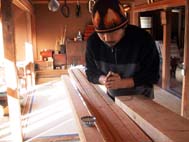
一本のトウヒの巨木から切り出した材だが、木目が微妙に違う。木目が違えば、たわみや反りの性質が違う。同じような性質の材を組合せ、バイダルカの骨組みは作らなくてはならない。その理由は追々お話ししよう。
その昔、アリュート達が海を行き交う姿を見て育ったのかもしれないトウヒ。
お神酒をあげ手を合わせ、トウヒに謝意し、人の命を乗せるに値するバイダルカが生まれる事を願う。
With lumber sawed up from one same tree, character is delicately different by each other. I will explain why we should put materials of the same property together at later chapter.
A tree which must have watched a lot of history. He might have been watching pack of baidarkas with Aleutian hunters passing along the coast line. I give a sacred liquor to praise his soul and show gratitude. Because, he becomes most important part of a baidarka, which will carry a human life and a soul.

2006年12月11日 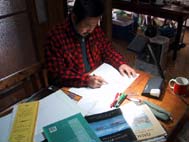 バイダルカのデータより数値を読み、断面図、型枠を起こす バイダルカのデータより数値を読み、断面図、型枠を起こす
熟練したネイティブのビルダーは、図面や定規などは一切使わず、感覚と経験でカヤックやカヌーの細かなサイズを決め作り上げる。具体的に説明すると、頭の中にあるバイダルカと乗り手を重ね合わせ、そのイメージにそって組み上げるのだ。バイダルカはプラモデルではないし、工業製品の様な企画品でもない。単純に所定のサイズのA部品とB部品を組みCを作るという作業ではない。
始めに在りきは個では無く、全体だ。全体のイメージに合わせて個を作る。抽象的で分かりにくい説明かもしれないが、この感覚が大切なのだ。この事を頭に置き、以下を読んで欲しい。
今回の趣旨は、過去にアリュートが作ったバイダルカを、できるだけ忠実に復元することだ。参考としたのは、Daivid W. Zimmerly著QAYAQに紹介されている1,934年にアトカ島で採取されたバイダルカのサイズの数値データーだ。このデーターは、バイダルカをCTスキャンしたような、バウ・前からスターン・後ろに所定の位置を決め、その位置の輪切り断面の数値だ。方眼紙を準備し、デッキビームセンター及びそのトップ、キールラインセンター及びそのアンダーの位置を写し線を引く。これがバイダルカの幅の中心線であり、デッキからキールまでの深さとなる。
この線を基準に、ガンネンルトップの位置を写し、デッキビームセンタートップから線を引く。この線がデッキ形状の基準となる。
さらに4本あるストリンガーの位置を写し、ガンネンルトップから下方向へ各ストリンガーを結び、キールラインセンターアンダーまで線を引く。この線がハル形状の基本となる。
さて、今引いた線はバイダルカのフレームに張られたスキンのラインだ。フレームはこのスキンの内側にある。つまり今引いた線の内側に、ガンネル、ストリンガー、キールの実寸断面を描かなくてはならない。それらの部材の内側の点を結び合わせた線が型枠となる。
方眼紙に書かれた型枠の線を、コンパネなどに写し切り出す。畳の上に並べられた写真が出来上がった型枠だ
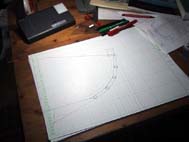  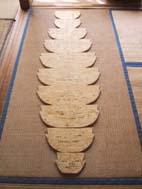
I examined data of baidarka from books and documents.
Builders of expert indigenous people make a canoe and a kayak based on a sense and experience. They do not use a drawing and rulers.
When I explain it to be concrete, at first a builder has to think about whether baidarka of what kind of performance will be suitable for a future paddler. And he/she realize the image and perform real building. Baidarka building is not a plastic-made scale model nor standardized goods such as an industrial product. Therefore, I can say that building a baidarka will be complicated work to demand all the ability of a builder.
A total image is important, not a part. So along a total image, you have to carry out a partial activity. Success of work is about whether you can always maintain this image in your mind.
The purpose of this project is reconstruction the baidarka which Aleut builder/paddler made in the past as possible precisely. I take dates into account from a book “QAJAQ” written by David W. Zimmerly. In this book, he introduced data of a baidarka which was gathered in Atka Island in 1934.
I omit the details, but any way based on these data, I took graph paper of shape of department (bow, stern, keel line, gunwale line, etc). These lines show the line of skin which was pitched on a framework.
I draw an one-first scale illustration of cut-off aspect of a framework, then I copied the line to plywood. And these become section form of a baidarka’s framework.
3 photos show process of the work. Right photo shows section forms.

12月15日 リブフレームの加工
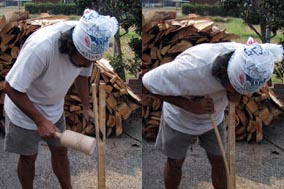 リブフレームはヒバもしくは檜(ひのき)の生木を使う。木目を生かすためには材を切り出すより、割り出さなくてはならない。最終的には直径1cm長さ80cmくらいの部材に仕上げるのだが、人間の肋骨のようにカヤックに配置される。 リブフレームはヒバもしくは檜(ひのき)の生木を使う。木目を生かすためには材を切り出すより、割り出さなくてはならない。最終的には直径1cm長さ80cmくらいの部材に仕上げるのだが、人間の肋骨のようにカヤックに配置される。
バイダルカで海を行く時、漕ぎ手を含め100kgを越えるバラストや荷物を積む。荒れた海上では、バイダルカはまるで生き物のように身体をうねらせるが、木目が通ってない部材を使うと折れてしまう。
海上でバイダルカが折れてしまえば、乗り手の命も折れてしまう。まずはアリュートが行った方法に近い作業を紹介する。
木目の通った材を選び、その材が半割になるように木口に鉈を当て、鉈の峰を木槌で打ち、割れ目を作る。割れ目に指を挟み込み、木目がまっすぐ走るように裂く。この工程を繰り返し、1.5cm角の角材を100本くらい作る。
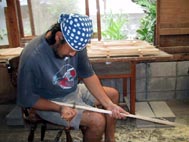 その角材をクロックドナイフあるいはインディアンナイフと呼ばれる、刃先が湾曲したナイフで直径1cmの材に削り上げてゆく。 その角材をクロックドナイフあるいはインディアンナイフと呼ばれる、刃先が湾曲したナイフで直径1cmの材に削り上げてゆく。
この方法の利点は、木目通った部材が作れ、道具が少なくてすむことだ。厳しい自然環境で生き抜くには、多くの道具より、知恵と思慮に満ちた多くの技術が必要なのだろう。
次に現代に即した方法で、日本の手道具を主体に使う作業を紹介する。
材木屋に足を運び、数多在る材の中から木目の通った無節の材を探す。四方柾もしくは二方柾と呼ばれる材だ。四方柾とは角材の4面に柾目が出た材を言い。二方柾とは角材の裏表2面に柾目が出た材を言う。1本の良質の丸太からごく僅かしか取れない部位だ。
その材を柾目に沿い製材にかけ、1.2cm角、長さ80cmの角材を100本作り、平鉋と内丸鉋を使い直径1cmの部材に仕立てる。出来上がったリブフレーム材は水に漬けて保管する。
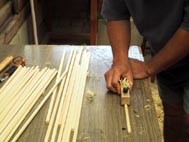 
部材のサイズは判りやすいように、メートル法で表記するが、本来は身体の部位を持って大きさを決める。なぜならカヤックは乗り手の身体に合わせて作るものだからだ。
Processing of rib frame
Yellow cedar or Japanese cypress tree will be the rib section of Baidarka. Two things are important.
1: Use materials before dry, I mean, while a tree is raw.
2: Break a tree along a grain of wood by using knife or wedge. Never use sawed up billet for rib frame.
A stave for rib frame is finished to a diameter of 1cm and 80cm in length finally. Rib frames are arranged like a human “Ribs”.
Baidarka carries more than 100kg with ballast and loads including a paddler on the sea..
On the rough sea, a frame of baidarka moves like a creature frame flexibly. The framework will be broken if you do not use right materials! If baidarka is broken on the sea, life of a paddler is broken, too.
Therefore I introduce the work procedure. This method seems that Aleutian kayak builder used to use.
Choose the materials which a grain goes straight. And put a hatchet edge on center of the stave’s section . Then knock on a back of a hatchet with a wooden hammer, put a crack in the section. Put a finger in a crack and tear a wood along a grain. Repeat this process and make about 100 square lumber of 1.5cm corner.
This square lumber has to be finish to round of a diameter 1cm with the knife which a blade bent. This special knife is called “crooked knife” or “Indian knife”.
An advantage of this method is that I can have a right material which a grain went natural for rib frame, And above all, that I do not need so many tools. I think that to survive in severe natural environment, a lot of “skill” full of wisdom and consideration is indispensability. Not tools.
Next I introduce work to use Japanese hand tools mainly. This technique may accord more in the present age.
Go to a lumber dealer and look for some lumber which has honest grain and free of knots. The lumber which you have to get is called in Japanese, “shihoumasa” or “nihoumasa”. “Shihoumasa”, you can see straight grains every 4 square of the lumber. “Nihoumasa”, you see them just at a side and the other side. I can say that you are lucky if you get those lumbers. Because those are extremely few parts which you can remove from one fine log.
Then saw up the fine lumber, make 100 square lumber 1.2cm corner, 80cm in length. You have to finish them to a diameter 1cm round with a plane ( straight blade, and inward bent blade. These are Japanese craftman’s traditional hand tools which are called “hiraganna” and “uchimaru gannna”).
Now you have gotten 100 rib lumber get ready. Then dip them into water and keep.
I transcribe dimension in metric system to make it plain. But traditionally, we have to decide size of baidarka with size of physical parts. Because, we have to build baidarka in conformity to a body of a paddler.
|







